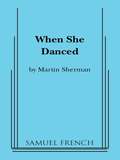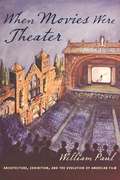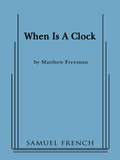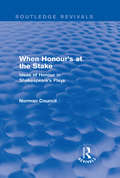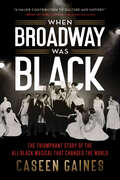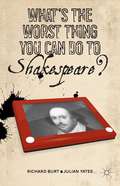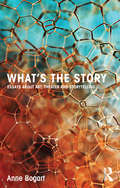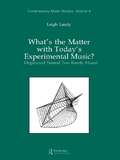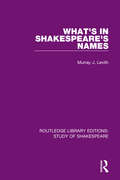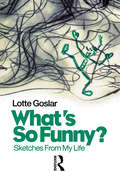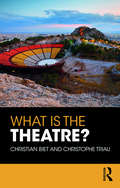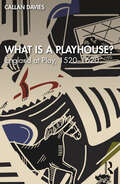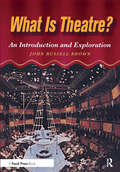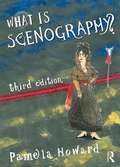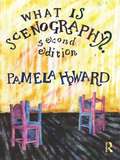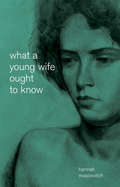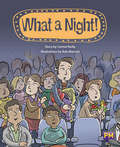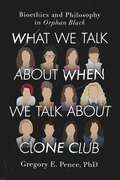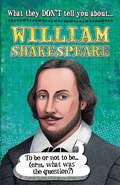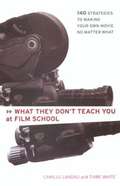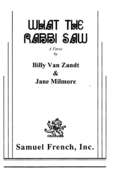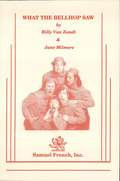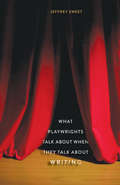- Table View
- List View
When She Danced (Plays Ser.)
by Martin ShermanDrama \ 3m, 5f \ Interior \ New York's Playwrights Horizons had a success starring Elizabeth Ashley as the legendary Isadora Duncan. The acclaimed author of Bent brings us Paris 1923, and Duncan's desperate attempts to keep herself financially solvent to realize her dream of retirement : a school in Italy to teach young dancers her art while distracted by her mercurial husband, a poet who only speaks Russian, as well as various acolytes, through whose eyes we glimpse the greatness of Isadora "when she danced". \ "A fascinating play.... A comic portrait of a Bohemian salon in both joy and extremis, as the calling of high art meets the low farce of insistent creditors, ludicrous lovers and unexpected guests. The very inexplicability of Isadora's art becomes ... a stirring emblem of its mysterious power to endure."- The New York Times
When Movies Were Theater: Architecture, Exhibition, and the Evolution of American Film (Film and Culture Series)
by William PaulThere was a time when seeing a movie meant more than seeing a film. The theater itself shaped the very perception of events on screen. This multilayered history tells the story of American film through the evolution of theater architecture and the surprisingly varied ways movies were shown, ranging from Edison's 1896 projections to the 1968 Cinerama premiere of Stanley Kubrick's 2001. William Paul matches distinct architectural forms to movie styles, showing how cinema's roots in theater influenced business practices, exhibition strategies, and film technologies.
When Is a Clock
by Matthew FreemanDramatic Comedy / 5m, 3f / Approximate running time: 1 hour and 45 minutes, no intermission. / Various settings, some real, some imaginary, in Pennsylvania / When Gordon's wife vanishes, the only clue to her whereabouts is a bookmark in dog-eared copy of Traveling to Montpelier. With little help to be found at work, from his son, or from the police, Gordon takes off to a rural bookstore to find some answers. His journey brings him to the town of Cornersville, in the wilds of Pennsylvania. Through a fractured narrative that is half-mystery and half-memory, we learn about Gordon’s marriage, his relationship with his son, his work-life and his wife’s bizarre entanglements with a mysterious stranger. We learn, too, about the nature of the landscape unique to the play: a magical universe with physics and laws that can both free the characters from their own stifling identities, and trap them as well. Synchronicity, dreams, and alchemy combine in this exploration of what it means to be able to – and unable to – change. At turns both scathingly funny and disturbingly compelling, When Is A Clock features Freeman's celebrated deconstruction of American culture - which has been called "nonviolent, though as savage as any slasher film" by the New York Times.
When Honour's at the Stake (Routledge Revivals)
by Norman CouncilRenaissance ideas of honour had a profound influence on the English people who formed Shakespeare’s audiences. In When Honour’s at the Stake, first published in 1973, Norman Council describes the increasing importance of these ideas to the themes and structure of a number of Shakespeare’s major plays. The validity of the most widely approved code of honour was being challenged on a variety of fronts, yet both personal standards of behaviour and public affairs were habitually understood in terms of honour. A series of tragedies are given their basic form by dramatizing the pernicious effects of man’s disobedience to the various demands of honour; in Julius Caesar, Troilus and Cressida, Hamlet, Othello, and King Lear honour is among the principal motives of tragedy. In this way, the modern reader’s comprehension of the plays can be greatly enhanced by reference to Elizabethan honour codes.
When Heroes Sing
by Sarah NooterThis book examines the lyrical voice of Sophocles' heroes and argues that their identities are grounded in poetic identity and power. It begins by looking at how voice can be distinguished in Greek tragedy and by exploring ways that the language of tragedy was influenced by other kinds of poetry in late fifth-century Athens. In subsequent chapters, Professor Nooter undertakes close readings of Sophocles' plays to show how the voice of each hero is inflected by song and other markers of lyric poetry. She then argues that the heroes' lyrical voices set them apart from their communities and lend them the authority and abilities of poets. Close analysis of the Greek texts is supplemented by translations and discussions of poetic features more generally, such as apostrophe and address. This study offers new insight into the ways that Sophoclean tragedy inherits and refracts the traditions of other poetic genres.
When Broadway Was Black: The Triumphant Story of the All-Black Musical that Changed the World
by Caseen GainesThe triumphant story of how an all-Black Broadway cast and crew changed musical theatre—and the world—forever."This musical introduced Black excellence to the Great White Way. Broadway was forever changed and we, who stand on the shoulders of our brilliant ancestors, are charged with the very often elusive task of carrying that torch into our present."—Billy Porter, Tony, Grammy, and Emmy Award-winning actor"The 1920s were the years of Manhattan's Black Renaissance. It began with Shuffle Along." —Langston HughesIf Hamilton, Rent, or West Side Story captured your heart, you'll love this in-depth look into the rise of the 1921 Broadway hit, Shuffle Along, the first all-Black musical to succeed on Broadway. No one was sure if America was ready for a show featuring nuanced, thoughtful portrayals of Black characters—and the potential fallout was terrifying. But from the first jazzy, syncopated beats of composers Noble Sissle and Eubie Blake, New York audiences fell head over heels.When Broadway Was Black is the story of how Sissle and Blake, along with comedians Flournoy Miller and Aubrey Lyles, overcame poverty, racism, and violence to harness the energy of the Harlem Renaissance and produce a runaway Broadway hit that launched the careers of many of the twentieth century's most beloved Black performers. Born in the shadow of slavery and establishing their careers at a time of increasing demands for racial justice and representation for people of color, they broke down innumerable barriers between Black and white communities at a crucial point in our history.Author and pop culture expert Caseen Gaines leads readers through the glitz and glamour of New York City during the Roaring Twenties to reveal the revolutionary impact one show had on generations of Americans, and how its legacy continues to resonate today.Praise for When Broadway Was Black:"A major contribution to culture."—Brian Jay Jones, New York Times bestselling author of Jim Henson: The Biography"With meticulous research and smooth storytelling, Caseen Gaines significantly deepens our understanding of one of the key cultural events that launched the Harlem Renaissance."—A Lelia Bundles, New York Times bestselling author of On Her Own Ground: The Life and Times of Madam C.J. Walker"Absorbing..."—The Wall Street JournalPreviously published as Footnotes: The Black Artists Who Rewrote the Rules of the Great White Way
What’s the Worst Thing You Can Do to Shakespeare?
by Richard BurtWhat's the worst thing you can do to Shakespeare? The answer is simple: don't read him. To that end, Richard Burt and Julian Yates embark on a project of un/reading the Bard, turning the conventional challenges into a roadmap for textual analysis and a thorough reconsideration of the plays in light of their absorption into global culture.
What's the Story: Essays about art, theater and storytelling
by Anne BogartAnne Bogart is an award-winning theatre maker, and a best-selling writer of books about theatre, art, and cultural politics. In this her latest collection of essays she explores the story-telling impulse, and asks how she, as a ‘product of postmodernism’, can reconnect to the primal act of making meaning and telling stories. She also asks how theatre practitioners can think of themselves not as stagers of plays but ‘orchestrators of social interactions’ and participants in an on-going dialogue about the future. We dream. And then occasionally we attempt to share our dreams with others. In recounting our dreams we try to construct a narrative... We also make stories out of our daytime existence. The human brain is a narrative creating machine that takes whatever happens and imposes chronology, meaning, cause and effect... We choose. We can choose to relate to our circumstances with bitterness or with openness. The stories that we tell determine nothing less than personal destiny. (From the introduction) This compelling new book is characteristically made up of chapters with one-word titles: Spaciousness, Narrative, Heat, Limits, Error, Politics, Arrest, Empathy, Opposition, Collaboration and Sustenance. In addition to dipping into neuroscience, performance theory and sociology, Bogart also recounts vivid stories from her own life. But as neuroscience indicates, the event of remembering what happened is in fact the creation of something new.
What's the Matter with Today's Experimental Music?: Organized Sound Too Rarely Heard (Contemporary Music Studies #4)
by Leigh LandyToday's education and communications media are seen to be the main cause of the anonymity of contemporary music and suggestions are made to improve this situation. Leigh Landy investigates audio-visual applications that have hardly been explored, new timbres and sound sources, the discovery of musical space, new notations, musical politics, and the 'musical community' in an attempt to incite more composers, musicians and musicologists to get this music out into the works and to stimulate the creation of new experimental works.
What's in Shakespeare's Names (Routledge Library Editions: Study of Shakespeare)
by Murray J. Levith‘What’s in a name? That which we call a rose/By any other name would smell as sweet.’ So says Juliet in the balcony scene from Romeo and Juliet but, originally published in 1978, Murray Levith shows just how wrong Juliet was. Shakespeare was extremely careful in his selection of names. Not only the obvious Hotspur or the descriptive Bottom or Snout, but most names in Shakespeare’s thirty-seven plays had a more than superficial significance. Beginning with what has been written previously, Levith illustrates how Shakespeare used names – not only those he invented in the later comedies, but those names bequeathed to him by history, myth, classical literature, or the Bible. Levith moves from the histories through the tragedies to the comedies, listing each significant name play by play, giving the allusions, references, and suggestions that show how each name enriches interpretations of action, character, and tone. Dr. Levith examines Shakespeare’s own name, and speculates upon the playwright’s identification with his characters and the often whimsical naming games he played or that were played upon him. A separate alphabetical index is provided to facilitate the location of individual names and, in addition, cross references to plays are given so that each name can be considered in the context of all the plays in which it appears.
What's The Story: Essays About Art, Theater And Storytelling
by Anne BogartAnne Bogart is an award-winning theatre maker, and a best-selling writer of books about theatre, art, and cultural politics. In this her latest collection of essays she explores the story-telling impulse, and asks how she, as a ‘product of postmodernism’, can reconnect to the primal act of making meaning and telling stories. She also asks how theatre practitioners can think of themselves not as stagers of plays but ‘orchestrators of social interactions’ and participants in an on-going dialogue about the future.
What's So Funny?: Sketches from My Life (Choreography and Dance Studies Series #Vol. 15)
by Lotte GoslarFirst Published in 1998. Routledge is an imprint of Taylor & Francis, an informa company.
What is the Theatre?
by Christian Biet Christophe TriauWhat is the Theatre? is one of the most coherent and systematic descriptions and analyses of the theatre yet compiled. Theatre is, above all, spectacle. It is a fleeting performance, delivered by actors and intended for spectators. It is a work of the body, an exercise of voice and gesture addressed to an audience, most often in a specific location and with a unique setting. This entertainment event rests on the delivery of a thing promised and expected – a particular and unique performance witnessed by spectators who have come to the site of the performance for this very reason. To witness theatre is to take into account the performance, but it is also to take into account the printed text as readable object and a written proposition. In this book, Christian Biet and Christophe Triau focus on the practical, theoretical and historical positions that the spectator and the reader have had in relation to the locations that they frequent and the texts that they handle. They adopt two approaches: analysing the spectacle in its theatrical and historical context in an attempt to seek out the principles and paradigms of approaching the theatre experience on one hand, and analysing the dramaturgy of a production in order to establish lines of interpretation and how to read, represent and stage a text, on the other. This approach allows us to better understand the ties that link those who participate in the theatre to the practitioners who create theatrical entertainment.
What is a Playhouse?: England at Play, 1520–1620
by Callan DaviesThis book offers an accessible introduction to England’s sixteenth- and early seventeenth-century playing industry and a fresh account of the architecture, multiple uses, communities, crowds, and proprietors of playhouses. It builds on recent scholarship and new documentary and archaeological discoveries to answer the questions: what did playhouses do, what did they look like, and how did they function? The book will accordingly introduce readers to a rich and exciting spectrum of "play" and playhouses, not only in London but also around England. The detailed but wide-ranging case studies examined here go beyond staged drama to explore early modern sport, gambling, music, drinking, and animal baiting; they recover the crucial influence of female playhouse owners and managers; and they recognise rich provincial performance cultures as well as the burgeoning of London’s theatre industry. This book will have wide appeal with readers across Shakespeare, early modern performance studies, theatre history, and social history.
What is Theatre?: An Introduction and Exploration
by John BrownThis major introductory textbook is from one of the leading educators working in theatre today. What Is Theatre? will make its reader a better playgoer, responding more fully to performance, with a keener appreciation of all the resources of theatre-acting, design, direction, organization, theatre buildings, and audiences. By focusing on the best professional practice and the most helpful learning processes, Dr. Brown shows how to read a play-text and to see and hear its potential for performance. Throughout this book, suggestions are given for student essays and class discussions, to help both instructor and reader to clarify their thoughts on all aspects of theatre-going. While the main focus is on present-day theatre in North America, history is used to illuminate current practice. Theatres in Europe and Asia also feature in the discussion. A view is given of all contributors to performance, with special emphasis placed on actors and the plays they perform. This textbook is not tied to a few specific play-texts, but designed to be effective regardless of which play a student sees or reads. In Part Two, leading practitioners of different generations and cultural backgrounds describe their own work, providing a variety of perspectives on the contemporary theatre. All this is supplemented by nearly 100 black and white and color illustrations from productions, working drawings, and plans. This new text engages its readers in the realities of the theatre; it is up-to-date, comprehensive, and packed with practical advice for understanding how theatre works and how plays come alive in performance. John Russell Brown is professor of Theatre at the University of Michigan, Ann Arbor, and has taught at a variety of colleges including New York and Stanford Universities. For 15 years he was an associate director of the National Theatre in London, and he has directed plays in many other theatres including Cincinnati Playhouse, the Empty Space in Seattle, and the Clurman Theatre in New York. Professor Brown has written extensively about theatre, especially about Shakespeare and contemporary theatre. He is editor of The Oxford Illustrated History of Theatre.
What is Scenography? (Theatre Concepts Ser.)
by Pamela HowardThe third edition of Pamela Howard’s What is Scenography? expands on the author’s holistic analysis of scenography as comprising space, text, research, art, performers, directors and spectators, to examine the changing nature of scenography in the twenty-first century. The book includes new investigations of recent production projects from Howard’s celebrated career, including Carmen and Charlotte: A Tri-Coloured Play with Music, full-colour illustrations of her recent work and updated commentary from a wide spectrum of contemporary theatre makers. This book is suitable for students in Scenography and Theatre Design courses, along with professional theatrical designers.
What is Scenography?
by Pamela Howard"Pamela Howard's ground-breaking What is Scenography? was the first book to set out the bold new approaches to designing and directing for theatre which had dazzled audiences in Europe during the previous decades. It did us all a service by enriching the scope of how we understand the aesthetics of the stage. The lavish new materials (drawings, colour photos, new production analysis) included in this second edition make it even more essential for anyone interested in new developments in theatre." - David Bradby "To write, design, organize, manage, sculpt, educate, paint, research and above all, to passionately live the life of the performance is what Pamela has done throughout her whole career and, in one way or another, it is reflected here in this book: the universality of stage design, its elements and its soul." - Ramon Ivars "Gives an excellent sense of scenography and a window on a life in the theatre - which is fascinating. ...A superb book." - Professor Arnold Aronson, Columbia University, USA "Pamela Howard is the precise definition of what a scenographer of today should be: a multiple artist. Her vast experience with space, her rare and acute power of reflection, her workshops worldwide, her masterful control of drawing and painting and her ability to interconnect scenography with other artistic expressions qualify her to discuss with great authority what "space for staging" should be in the coming decades of this millennium." - Jose Carlos SerroniPamela Howard's What is Scenography? has become a classic text in contemporary theatre design and performance practice. In this second edition, the author expands on her holistic analysis of scenography as comprising space, text, research, art, performers, directors and spectators, to examine the changing nature of scenography in the twenty-first century. The book includes: case studies and anecdotes from Howard's own celebrated career illustrations of her own recent work, in full colour throughout an updated 'world view' of scenography, with definitions from the world's most famous and influential scenographers A direct and personal response to the question of how to define scenography by one of the world's leading practitioners, What is Scenography? continues to shape the work of visual theatremakers throughout the world.
What a Young Wife Ought to Know
by Hannah MoscovitchJust don’t lie down and no child will come.It’s Ottawa in the 1920s, pre-legalized birth control. Sophie, a young working-class girl, falls madly in love with and marries a stable-hand named Jonny. After two difficult childbirths, doctors tell Sophie she shouldn’t have any more children, but don’t tell her how to prevent it. When Sophie inevitably becomes pregnant again, she faces a grim dilemma.In an unflinching look at love, sex, and fertility, and inspired by real stories of mothers during the Canadian birth-control movement of the early twentieth century, one of Canada’s most celebrated playwrights vividly recreates a couple’s struggles with reproduction.
What a Night! (Into Reading, Level N #77)
by Carmel Reilly Rob ManciniNIMAC-sourced textbook <p><p> Kayla, Joe and Dad are on their way to the Grand Theatre in the city. They are so excited to see Mum perform in a musical! But then something terrible happens – the car won’t start! How will they get to the theatre now?
What We Talk About When We Talk About Clone Club: Bioethics and Philosophy in Orphan Black
by Gregory E. PenceWhat is the real-world history and science of human cloning, and does Orphan Black get it right? Can you "own" a person—even a cloned one? How can Sarah Manning be straight, Cosima gay, and Tony trans? Cult hit sci-fi show Orphan Black doesn't just entertain—it also raises fascinating questions about human cloning, its ethics, and its impact on personal identity. In What We Talk About When We Talk About Clone Club: Bioethics and Philosophy in Orphan Black, prominent bioethicist Gregory E. Pence violates Clone Club's first rule to take us deeper into the show and its connections to the real world, including: Widespread myths about human clones (and Orphan Black's rejection of them) Our ugly history of eugenics The ethics of human experimentation, by way of Projects Castor and Leda What we can learn about clones and identity from twin studies and tensions among Orphan Black's clone "sisters" Kendall Malone and other genetic anomalies The brave new world of genetic enhancement and clonal dynasties, and how Helena and Kira Manning fit in In the process, What We Talk About When We Talk About Clone Club reveals why Orphan Black is some of today's most engaging and thought-provoking television.
What They Don't Tell You About: William Shakespeare
by Anita GaneriDid you know that Shakespeare couldn't spell his own surname? Love him or hate him, everyone has heard of the world's most famous playwright. But did the Elizabethans think he was a genius or simply that he wrote great soap operas? Any book on Shakespeare will give you the boring facts THEY think you should know, but only this one will tell you what the bard and his mates were REALLY like ... Uncover a wealth of information about Shakespeare! Find out where he was born and look at his family tree, see a map of Shakespeare's Stratford and Shakespeare's London, find out what school was like in Shakespeare's time, what London life was like and what sort of people went to the theatre. See a cross-section illustration of the Globe and discover how special effects were created and what actors wore. Read biographies of famous actors of the era such as Edward Alleyn, Richard Burbage, Richard Tarlton and William Kempe as well as biographies of contemporary writers Ben Jonson, Thomas Kyd and Christopher Marlowe. Read famous quotes and sayings and whizz your eye over a timeline of Shakespeare's plays and of his life. This book will tell you what Shakespeare's longest or shortest play is, or even which is the most miserable or goriest? It includes plots and information about ten of Shakespeare's plays: Richard III; Romeo and Juliet; A Midsummer Night's Dream; The Merchant of Venice; Henry V; Twelfth Night; Hamlet; Othello; Macbeth and The Tempest. It highlights some of Shakespeare's funniest characters and some of those that were in love. It concludes looking at how Shakespeare died, and discusses whether Shakespeare was, in fact, Sir Francis Bacon, Edward De Vere, Roger Manners, William Stanley or Christopher Marlowe. Finally, test your knowledge of all you've read with a fun 20-question quiz.
What They Don't Teach You at Film School: 161 Strategies For Making Your Own Movie No Matter What
by Camille Landau Tiara White<p>Two filmmakers who've beaten the system give the real dope on what it takes to get your movie made. <p>Do you have to go to film school to get your movies made? No, say two young entrepreneurs who survived the grind. Here they offer 140 strategies for making movies no matter what. Amateurs as well as seasoned veterans can pick up this entertaining and incredibly useful guide in any place--at any point of crisis--and find tactics that work. Whether it's raising money or cutting your budget; dealing with angry landlords or angry cops; or jump-starting the production or stalling it while you finish the script, these strategies are delivered with funny, illustrative anecdotes from the authors' experiences and from veteran filmmakers eager to share their stories. Irreverent, invaluable, and a lot cheaper than a year's tuition, this friendly guide is the smartest investment any future filmmaker could make. <p>Strategies from the book include: Love your friends for criticizing your work--especially at the script stage; Shyness won't get you the donuts; Duct tape miracles; Don't fall in love with cast or crew (but if you do...).
What The Rabbi Saw
by Jane Milmore Billy Van ZandtFarce / 7m, 4f / Interior / Adrienne Barbeau headed the cast of this crazy slapstick farce which takes pre wedding jitters to nightmare proportions. In a posh New York hotel just before Walter and Wendy are scheduled to say "I do", Walter's zipper becomes attached to his bride's sister's dress during a last minute act of infidelity. Meanwhile Wendy is having a fling with the best man. This finely tuned exercise in physical comedy zips from one hilarious situation as all try to hide their exploits and make it to the church on time.
What The Bellhop Saw
by Jane Milmore Billy Van ZandtFarce / 8m, 4f / Interior / A nice fellow checks into an expensive suite in New York City's finest hotel, precipitating a fantastic nightmare involving a Salman Rushdie type author, an Iranian terrorist, a shrew like woman, a conniving bellboy, an incompetent F.B.I. agent, a nubile celebrity mad maid, a dimwitted secretary and a little pig tailed girl. Gag lines are popping as events transpire at a whirlwind velocity. Topical humor blends with the traditional antics of farce: doors slamming, characters careening and confusion reigning supreme.
What Playwrights Talk About When They Talk About Writing
by Jeffrey SweetThe art and craft of playwriting as explored in candid conversations with some of the most important contemporary dramatists Edward Albee, Lanford Wilson, Lynn Nottage, A. R. Gurney, and a host of other major creative voices of the theater discuss the art of playwriting, from inspiration to production, in a volume that marks the tenth anniversary of the Yale Drama Series and the David Charles Horn Foundation Prize for emerging playwrights. Jeffrey Sweet, himself an award-winning dramatist, hosts a virtual roundtable of perspectives on how to tell stories onstage featuring extensive interviews with a gallery of gifted contemporary dramatists. In their own words, Arthur Kopit, Marsha Norman, Christopher Durang, David Hare, and many others offer insights into all aspects of the creative writing process as well as their personal views on the business, politics, and fraternity of professional theater. This essential work will give playwrights and playgoers alike a deeper and more profound appreciation of the art form they love.
